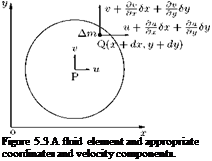Vorticity Equation in Rectangular Coordinates
In a two-dimensional motion, the vorticity at a point P, which is located perpendicular to the plane, is equal to the limit of the ratio of the circulation in an infinitesimal circuit embracing P to the area of the circuit.
A flow possesses vorticity if any of its elements are rotating (spinning). It is a convenient way to investigate the motion of a circular element, treating it as a solid, at the instant of time considered. Let P(x, y) be the center of the circular element and u and v are the velocity components, along x – and y-directions, respectively, as shown in Figure 5.3.
 |
Let us assume that the fluid element consists of numerous fluid particles of mass Am each, such as one at the point Q(x + Sx, y + Sy). At point Q, the velocity components, along x – and y-directions,
dv dv
v +—- Sx +—– Sy.
dx dy
The moment of momentum (or angular momentum) of the fluid element about point P(x, y) is the sum of the moments of momentum of all the particles such as Q about point P. Taking the anti-clockwise moment as positive, we have:
Moment of momentum of the element
|
E |
{ dv du.
AmYy — dx 1 SxSy.
For a circular disc, about its center, we have:
У ‘ Am SxSy = 0.
Therefore, the angular momentum of the disc becomes:
|
E |
dv 2 X—> du 2
Am — (Sx) — У Am — (Sy) . dx ^’ dy
If the disc were a solid disc, its angular momentum would be Ію, where I is its polar moment of inertia about P and ю its angular velocity about P. Thus, assuming the fluid element as a solid disc, we have:
I = Am {(Sx)2 + (Sy)2}
and
YsAm (Sx)2 = E Am (Sy)2.
Thus, we have the angular momentum relation as:
m^2Am {(Sx)2 + (sy)2} = EAmdx(Sx)2—EAmdy(Sy)2.
This gives the angular velocity as:
^ dv du dx dy
The quantity 2w is the elemental spin, also referred to as vorticity, which is usually denoted as Z. Thus,
![]() (5.1)
(5.1)
The units of Z are radian per second. From Equation (5.1) and the angular velocity relation, it is seen that:
that is, the vorticity is twice the angular velocity.











